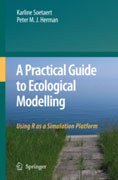
A practical guide to ecological modelling: using R as a simulation platform
Soetaert, K.
Herman, P.M.
Mathematical modelling is an essential tool in present-day ecological research. Yet for many ecologists it is still problematic to apply modelling in theirresearch. In our experience, the major problem is at the conceptual level: proper understanding of what a model is, how ecological relations can be translated consistently into mathematical equations, how models are solved, steady states calculated and interpreted. Many textbooks jump over these conceptual hurdles to dive into detailed formulations or the mathematics of solution. This book attempts to fill that gap. It introduces essential concepts for mathematical modelling, explains the mathematics behind the methods, and helps readers to implement models and obtain hands-on experience. Throughout the book, emphasis is laid on how to translate ecological questions into interpretable models in a practical way. Emphasis on the conceptual and mathematical basis of modelling Coverage of a wide range of ecological models All points illustrated in worked-out examples All examples implemented in the freely available open-source package R All code for examples and exercises available from a web site INDICE: Preface.- 1. Introduction.- 2. Model formulation.- 3. Spatial components and transport.- 4. Parameterisation.- 5. Model solution - analytical methods.- 6. Model solution - numerical methods.- 7. Stability and steady-state.- 8. Multiple time scales and equilibrium processes.- Discrete time models.- 10. Dynamic programming.- 11. Testing and validating the model.- 12. Further reading and references.
- ISBN: 978-1-4020-8623-6
- Editorial: Springer
- Encuadernacion: Cartoné
- Páginas: 276
- Fecha Publicación: 01/10/2008
- Nº Volúmenes: 1
- Idioma: Inglés
